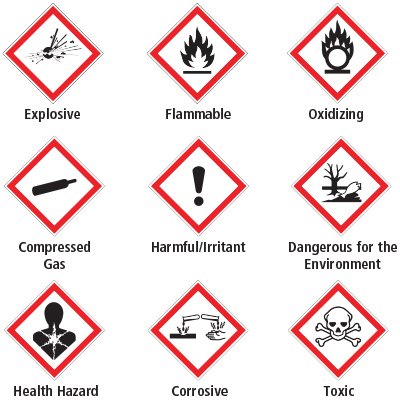Aligning Your Hazard Communication Program with GHS
Posted November 14, 2018
In 2003, the United Nations (UN) adopted the Globally Harmonized System of Classification and Labeling of Chemicals (GHS). It includes criteria classifying health, physical and environmental hazards. It also specifies what information should be included on labels of chemicals, as well as safety data sheets.
The United States has been working to move its hazard communication rules into compliance with GHS since 2005, with the final rule being issued by the Occupational Health and Safety Administration (OSHA) in 2012. All workplaces were required to complete training regarding the new labels and safety data sheet formats by late 2013. Chemical manufacturers now must comply with all provisions—namely the universal use of new labels and Safety Data Sheets (SDS).
Why the Change?
In an increasingly globalized world, the conversion to GHS improves the protection of human health and the environment by providing an internationally comprehensible system for hazard communication. According to the EPA, the GHS will ensure more consistency in the classification and labeling of all chemicals, thereby improving and simplifying hazard communication. This improved communication system will alert the user to the presence of a hazard and the need to minimize exposure and risk, resulting in safer transportation, handling and use of chemicals.
GHS Basics
The GHS classifies chemicals according to their health, physical and environmental hazards. It uses pictograms, hazard statements, and the signal words “Danger” and “Warning” to communicate hazard information on product labels and SDSs.
Product Labels
Chemical manufacturers and importers are required to provide a harmonized signal word, pictogram and hazard statement for each class and category. Precautionary statements must also be provided. The most important elements of GHS-compliant labels are the following:
- Hazard statements: A phrase assigned to each hazard category; examples include “harmful if swallowed,” and “highly flammable liquid and vapor.”
- Pictograms: A symbol inside a diamond with a red border, denoting a particular hazard class. There are nine pictograms, although pictograms can indicate an entire family of hazards.
- Precautionary statement(s): Phrases that recommend measures that should be taken to minimize or prevent adverse effects resulting from exposure or improper handling. GHS provides guidance on cautionary statements and includes a list of statements that may be used.
- Product identifiers: Under GHS, labels for substances should include the identity of the substance. Label mixtures should include the identities of ingredients that are responsible for certain hazards on the label—there are exceptions to this based on confidential business information.
- Signal word: The label and SDS should include a signal word to indicate the relative severity of the hazard. “Warning” is used for less severe hazard categories and “Danger” for more severe hazard categories. Lower categories of classification, and unclassified products, do not require pictograms or signal words under GHS.
- Supplier identification: GHS requires the label to contain the name, address and telephone number of the manufacturer or supplier of the substance.
GHS Safety Data Sheets
The SDSs are similar to the American National Standards Institute (ANSI) requirements for Material Safety Data Sheets (MSDS), although sections two and three have been reversed. The SDS should provide a clear description of the data used to identify the hazards. The minimum information required by a GHS-compliant SDS includes the following:
- Identification of the substance or mixture, and of the supplier
- Hazards identification
- Composition/information on ingredients
- First aid measures
- Firefighting measures
- Accidental release measures
- Handling and storage guidelines
- Exposure controls/personal protection
- Physical and chemical properties
- Stability and reactivity
- Toxicological information
- Ecological information
- Disposal considerations
- Transport information
- Regulatory information
- Other information including information on preparation and revision of the SDS
The conversion from traditional methods of hazard communication to GHS may be difficult to navigate. Contact Horst Insurance for ongoing support on building and maintaining your OSHA compliance program.

